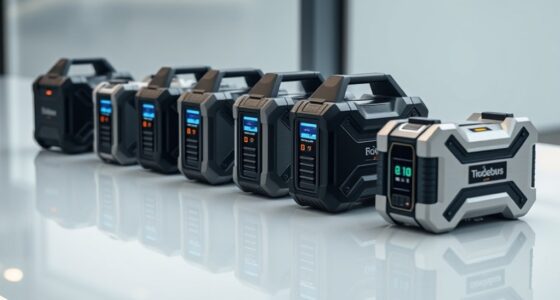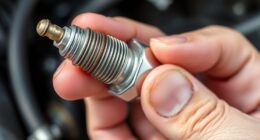If you’re after top-tier chip modules that deliver maximum power and precision, I recommend considering high-performance ignition modules like the ACCEL 35371 for Ford TFI, industrial thermoelectric modules such as TEC1-12712 for thermal management, and precision operational amplifiers like the OPA828 for accuracy. Relays like the HYCRT8-J1 or lightning protectors also enhance reliability. For advanced development, options like the Damp-100 amplifier board and the LILYGO T-Display-S3 touchscreen are excellent. Keep exploring these options to find the best fit for your project.
Key Takeaways
- Top-tier modules like the Damp-100 Tpa3221 amplifier ensure high-quality audio power and long-lasting performance.
- Precision components such as the OPA828 operational amplifiers deliver ultra-low offset and high accuracy in signal processing.
- Advanced modules like thermoelectric coolers (TEC1-12712) provide precise thermal management for demanding applications.
- High-performance relays, including time delay and lightning protection modules, guarantee reliable operation in critical environments.
- Durable, high-quality materials and clear installation features optimize reliability and ultimate control in professional systems.
ACCEL 35371 High Performance Ignition Module for Ford TFI

If you own a Ford with a black control module and want to boost your engine’s ignition performance, the ACCEL 35371 High Performance Ignition Module is worth considering. Designed specifically for Ford TFI remote-mounted modules, it offers high coil output, reliability, and overheating protection. Weighing just 2.4 ounces, it’s compact and durable, with features to resist false triggering from RFI sources. Proper installation is key—ensure your vehicle has a black control module, clean mounting surfaces, and follow the manufacturer’s steps. When installed correctly, it can improve engine responsiveness, especially in trucks like the F150 5.0 or F350 5.8.
Best For: Ford truck owners with a black control module seeking to enhance ignition performance and reliability.
Pros:
- High coil output and superior reliability for long coil life
- Overheating protection and resistance to false triggering from RFI sources
- Compact design weighing only 2.4 ounces, suitable for remote mounting
Cons:
- Compatibility issues if installed in vehicles with gray control modules, leading to misfires or engine stalls
- May not produce noticeable performance gains unless paired with additional ignition upgrades
- Potential for drivability problems or engine surging if incorrectly installed or used in incompatible models
Industrial-Grade Thermoelectric Module TEC1-12712 (50×50, 12V12A)
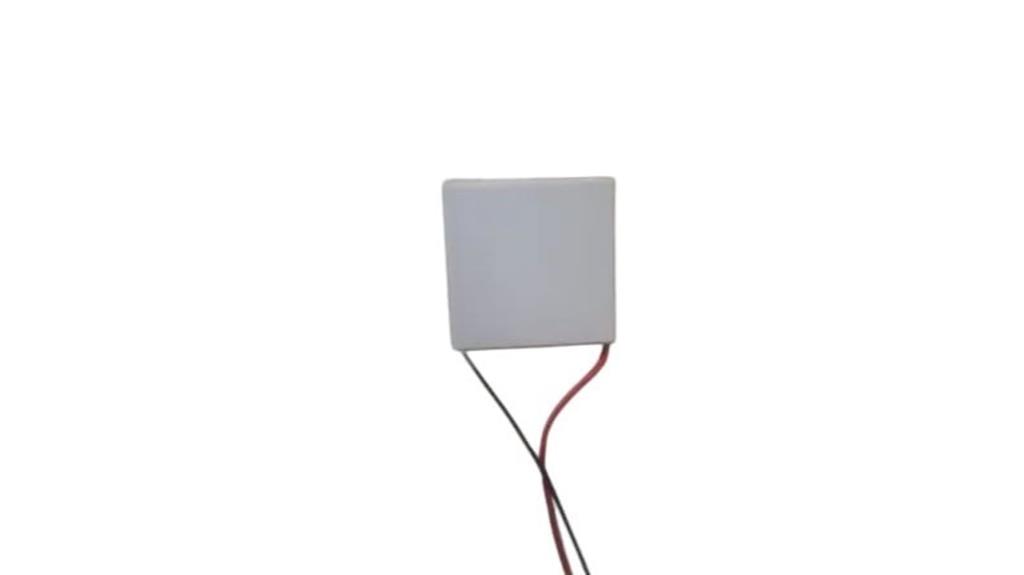
The Industrial-Grade Thermoelectric Module TEC1-12712 is an excellent choice for professionals who need reliable, high-performance cooling solutions in demanding environments. With its large 50x50mm size and 12V, 12A power capacity, it delivers precise and stable thermal management. Crafted with top-quality electronic components, this module guarantees durability and long-lasting performance. Its user-friendly design and clear instructions make installation straightforward. Suitable for industrial, automotive, and household electronics, it offers versatile cooling options. Plus, with a customer-focused approach, including a money-back guarantee and expert support, this thermoelectric module stands out as a dependable, high-end solution for demanding applications.
Best For: professionals and DIY enthusiasts seeking reliable, high-performance cooling solutions for industrial, automotive, or household electronic applications.
Pros:
- High-capacity 12V, 12A power output ensures strong cooling performance
- Durable construction with top-quality electronic components for long-lasting use
- User-friendly design with clear instructions simplifies installation
Cons:
- Larger size (50x50mm) may require additional space in compact setups
- May need additional heatsinks or fans for optimal efficiency in some environments
- Not suitable for low-power or small-scale cooling projects
OPA828 DIP8 Dual Operational Amplifier Chip Dual OP AMP
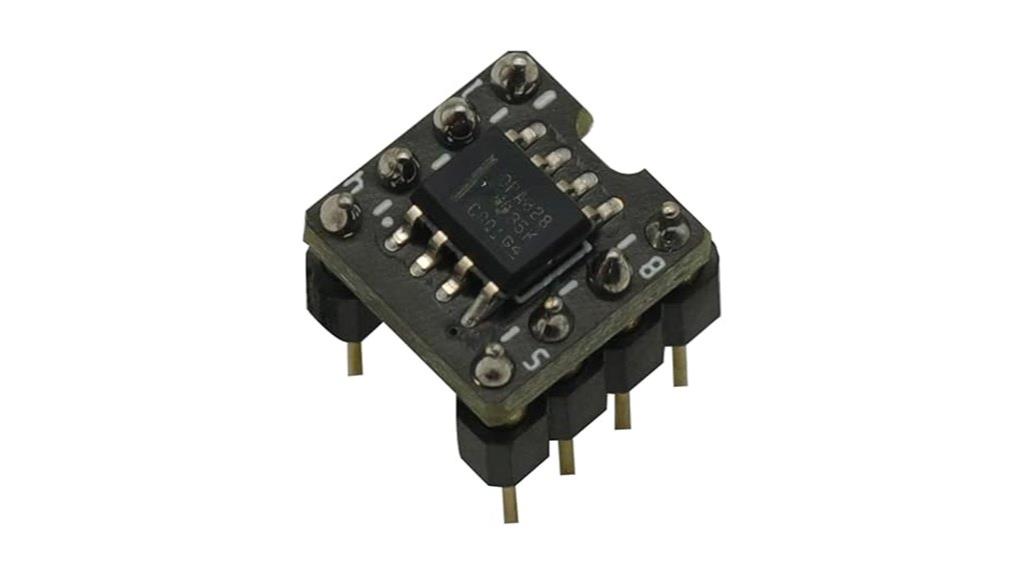
For audio enthusiasts and high-precision applications, the OPA828 DIP8 Dual Operational Amplifier Chip stands out with its low offset voltage of just 50μV, ensuring exceptional accuracy and minimal signal distortion. Its wide power supply range of ±4V to ±18V makes it versatile for various setups, while low bias current and temperature drift enhance stability. Designed as an upgraded version of the OPA627, it surpasses many traditional op amps like NE5532 and OPA2604, delivering superior transparency, detailed sound, and clarity. Its dual-op-amp package offers high-speed performance and precision, making it ideal for audiophile gear, DACs, and high-end audio projects.
Best For: audio enthusiasts, high-precision audio equipment builders, and professional audio engineers seeking superior sound clarity and accuracy.
Pros:
- Low offset voltage of only 50μV ensures high accuracy and minimal distortion
- Wide power supply range of ±4V to ±18V offers versatile compatibility
- Superior transparency and detailed sound quality outperform traditional op amps like NE5532 and OPA2604
Cons:
- Contains two separate op amps in one DIP8 package, not a single dual op amp, which may require additional setup considerations
- Slightly more complex installation compared to standard single op amps
- May be overkill for basic audio applications where high precision is not required
Asymmetric Cycle Time Relay HYCRT8-J1

The Asymmetric Cycle Time Relay HYCRT8-J1 stands out for its wide delay range, making it ideal for precise timing control in industrial automation. It offers adjustable delays from just 0.1 seconds up to 10 days, providing versatile timing options. The relay operates on AC/DC voltage from 24 to 240V, with a 16A current capacity, ensuring reliable performance across various applications. Its flame-retardant shell, LED indicators, and knob adjustments make setup straightforward. Designed for stability and safety, it mounts easily on a standard DIN rail. This relay is perfect for delaying equipment startup, controlling furnace blowers, or managing automation sequences with accuracy.
Best For: industrial automation professionals needing precise and versatile time delay control for equipment startup, furnace management, or process sequencing.
Pros:
- Wide delay range from 0.1 seconds to 10 days allows for flexible timing applications.
- Reliable operation with stable performance and high current capacity of 16A.
- Easy installation with DIN rail mounting, clear wiring diagram, and user-friendly knob adjustments.
Cons:
- Unclear wiring instructions may cause setup difficulties for some users.
- Potential for initial defects or wiring errors leading to operational issues.
- May operate as an on-delay rather than off-delay if not properly configured.
2P Anti-Thunder Modular Arc Module Protector

If you’re seeking reliable thunder protection for your home or business, the P Anti-Thunder Modular Arc Module Protector stands out thanks to its quick 0.2-second response time and ability to handle up to 40kA of current. This 2P device offers superior safety and quality assurance through strict manufacturing controls, ensuring reliable performance and peace of mind. Its internal components feature accurate chips and strong conductivity, enhancing thunder protection and durability. Designed to be compact, lightweight, and made from high-quality materials, it’s easy to install, carry, and store. Overall, this protector provides precise, long-lasting defense against lightning strikes, safeguarding your valuable appliances and infrastructure.
Best For: homeowners and businesses seeking reliable lightning protection for their electrical systems and appliances.
Pros:
- Rapid 0.2-second response time for immediate lightning strike protection
- Handles up to 40kA current, providing robust safety against powerful strikes
- Compact, lightweight design makes installation and maintenance easy
Cons:
- May require professional installation for optimal performance
- Limited to 2P configurations, not suitable for all electrical setups
- Potential higher cost compared to basic surge protectors
Damp-100 TPA3221 Amplifier Board, High-End Finished Module
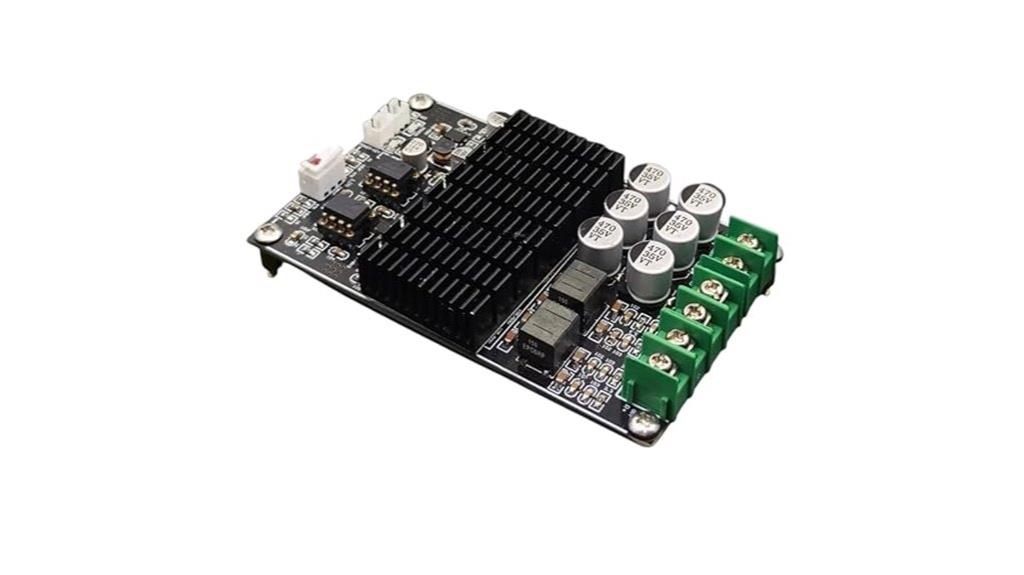
When seeking a high-performance amplifier module that combines reliability with exceptional audio clarity, the Damp-100 TPA3221 Amplifier Board stands out as an ideal choice. This high-end finished digital D-Class dual channel HiFi amplifier uses top-quality electronic components, ensuring long-lasting, dependable performance. Its DIY-friendly design makes installation straightforward, and it’s suitable for diverse applications like industrial, automotive, or household electronics. With built-in integrated circuits, chips, and voltage regulators, it’s engineered for superior heat dissipation. Plus, the product is supported by knowledgeable customer service and a money-back guarantee, reflecting its quality and commitment to excellence.
Best For: audiophiles, DIY electronics enthusiasts, and professionals seeking reliable, high-quality amplification solutions across industrial, automotive, or household applications.
Pros:
- Utilizes top-quality electronic components for long-lasting performance
- Easy to install and compatible with various electronic devices
- Designed for excellent heat dissipation, ensuring stable operation
Cons:
- May require technical knowledge for optimal setup and integration
- Compatibility inquiries suggest some users might need support before purchasing
- No specific details on power output or size constraints
Damp-100 Tpa3221 Amplifier Board, High-End Finished Module
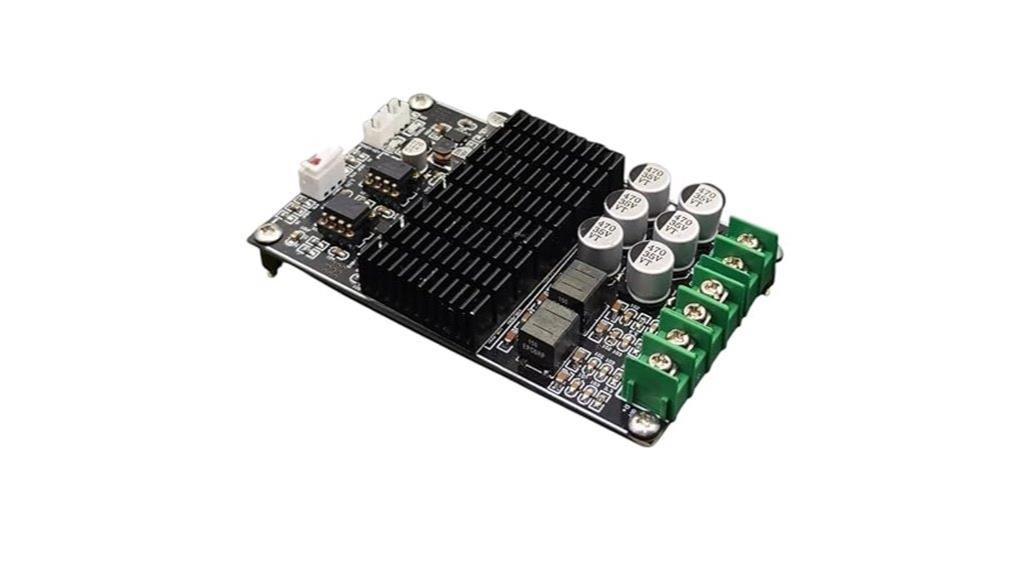
For audiophiles and electronics enthusiasts seeking premium sound quality and reliable performance, the Damp-100 Tpa3221 Amplifier Board stands out as an ideal high-end finished module. Made with top-quality electronic components and durable metal, it guarantees long-lasting, consistent operation. Its digital D-Class dual-channel design delivers clear, powerful audio suited for HiFi systems, automotive setups, and DIY projects. Designed for easy installation, it comes with clear instructions and a customer support team ready to assist. With a money-back guarantee, I trust this module offers both exceptional performance and peace of mind, making it a top choice for high-end amplification needs.
Best For: audiophiles, electronics enthusiasts, and DIYers seeking high-quality, reliable amplification for HiFi, automotive, or household audio systems.
Pros:
- Made with top-quality electronic components for durability and performance
- Easy to install with clear instructions, suitable for beginners and experts
- Versatile application in various electronic projects and professional setups
Cons:
- May require additional accessories or power sources for optimal operation
- Not designed for extremely high-temperature environments
- Limited information on specific compatibility details in the provided description
LILYGO T-Display-S3 AMOLED ESP32-S3 Development Board with Touchscreen

Looking for a development board that combines vibrant visuals with powerful connectivity? The LILYGO T-Display-S3 AMOLED ESP32-S3 fits the bill perfectly. It features a sharp 1.9-inch AMOLED touchscreen, delivering crisp, colorful visuals ideal for detailed interfaces. Powered by the ESP32-S3 chipset with LPDDR4X RAM, it runs on Linux OS, supporting WiFi 802.11ax and Bluetooth 5.0 for seamless wireless communication. Designed for developers, it offers extensive libraries and examples, simplifying custom app creation. With soldered pins and broad community support, this board is an excellent choice for IoT projects requiring high-end performance, vibrant displays, and versatile connectivity.
Best For: developers and hobbyists seeking a high-performance, vibrant display IoT device with versatile wireless connectivity and extensive programming support.
Pros:
- Features a bright 1.9-inch AMOLED touchscreen with high resolution for crisp, colorful visuals
- Supports WiFi 802.11ax and Bluetooth 5.0 for advanced wireless communication
- Powered by the powerful ESP32-S3 chipset with LPDDR4X RAM, ideal for complex applications
Cons:
- Soldered pins may limit hardware customization or expansion options
- Limited to Linux OS, which might require familiarity for development
- Smaller display size may not be suitable for applications requiring larger screens
Cyclic Time Delay Relay with Digital Display

The Cyclic Time Delay Relay with Digital Display stands out as an ideal choice for industrial professionals who need precise and flexible timing control. Its wide delay range from 0.1 seconds to 99 hours allows for versatile applications, whether in lighting, manufacturing, or automation. The digital display makes programming straightforward, with LED indicators providing real-time status updates. Built with a flame-retardant shell and DIN rail mounting, it’s safe and easy to install. Although some find programming complex initially, its stability and customization options make it a reliable, high-end solution for demanding environments. This relay ensures accurate, dependable timing for various industrial needs.
Best For: industrial professionals and automation engineers seeking precise, flexible, and reliable time delay control solutions for lighting, manufacturing, and equipment automation.
Pros:
- Wide delay range from 0.1 seconds to 99 hours offers high flexibility for various applications
- Digital display and LED indicators facilitate easy programming and real-time status monitoring
- DIN rail mounting and flame-retardant shell ensure safe, stable, and straightforward installation
Cons:
- Initial programming can be complex, especially for setting registers via the digital interface
- Modifying the program may be time-consuming, which could be inconvenient for frequent adjustments
- Requires some technical knowledge for optimal setup and operation
Factors to Consider When Choosing High End Performance Chip Modules
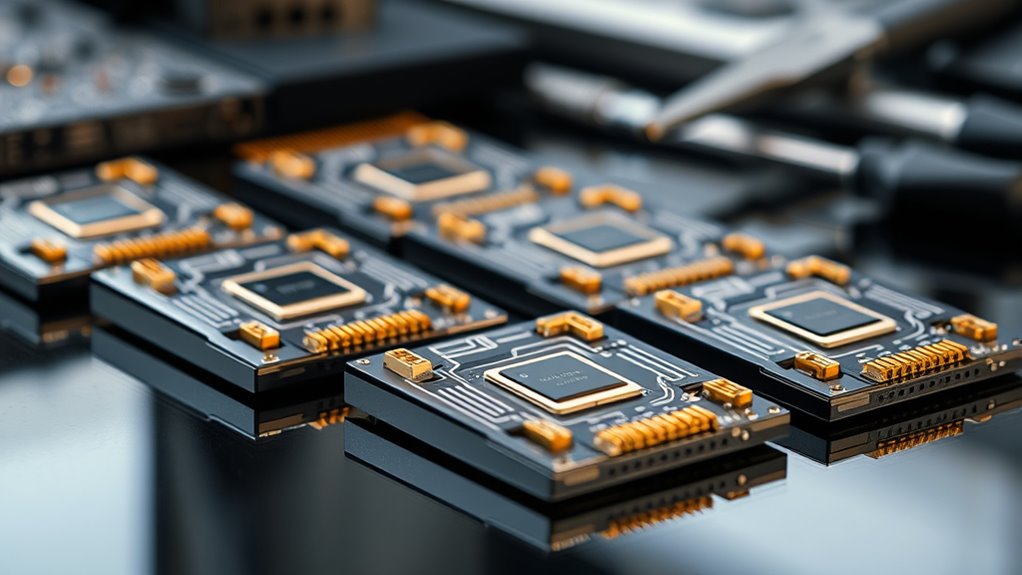
When selecting high-end performance chip modules, I focus on key factors like compatibility with my devices and the power requirements to guarantee smooth operation. I also consider the performance specs and how easy it is to install, so I don’t face unnecessary hurdles. Finally, I pay attention to material durability to make sure the module will last under demanding conditions.
Compatibility With Devices
Choosing the right high-end performance chip module hinges on guaranteeing it’s fully compatible with your device. First, check that the module’s voltage and current ratings match your device’s requirements to avoid damage or performance issues. It’s also vital to verify that the form factor and pin configuration align with your device’s connectors and mounting options. Compatibility with your device’s operating system or firmware is essential—look for supported interface protocols and communication standards. Additionally, review the module’s feature set, such as noise performance and temperature range, to make certain it can handle your high-performance needs. Finally, consult manufacturer specifications and documentation to confirm the module is designed for your specific application, ensuring seamless integration and peak operation.
Power and Voltage Needs
Ensuring your high-end performance chip module receives the correct power and voltage is essential for peak operation. Stable power supplies within specific voltage ranges, like ±4V to ±18V for op-amps such as the OPA828, are critical. Matching your module’s voltage rating to your power source prevents damage and keeps performance ideal. Adequate current capacity is equally important; for example, TEC1-12712 thermoelectric modules need around 12A at 12V to function effectively. Overvoltage or undervoltage conditions can lead to instability, reduced lifespan, or malfunctions. Proper power management—including filtering and regulation—is vital to deliver clean, consistent voltage, ensuring your high-performance chip operates reliably and at its best. Always verify power specifications before integrating a module into your setup.
Performance Specifications
Performance specifications are essential factors to contemplate because they directly impact the accuracy, stability, and overall reliability of high-end chip modules. I look for modules with low offset voltages—around 50μV or less—to ensure precise signal processing. Low noise levels, approximately 4nV/√Hz, are critical for maintaining high fidelity in audio and sensitive measurements. I also prioritize modules designed with wide power supply voltage ranges, from ±4V to ±18V, offering versatility across systems. Additionally, low bias currents in the picoampere range help minimize signal distortion, especially in high-impedance circuits. Stability over temperature is crucial, so I check for low temperature drift, around 0.45μV/°C, to guarantee consistent performance. These specifications ensure I select modules delivering ultimate accuracy and dependable operation.
Ease of Installation
When selecting high-end performance chip modules, ease of installation plays a crucial role in ensuring a smooth setup process. Many modules are designed with user-friendly features like clear instructions, labeled wiring diagrams, and accessible connectors, making installation straightforward. Standardized mounting options such as DIN rails or screw terminals further simplify integration into existing systems. Modules with plug-and-play interfaces or compatible socket connections can drastically reduce setup time and technical challenges. Additionally, proper installation usually requires minimal tools and can often be completed by users with basic technical skills, provided detailed instructions are available. This ease of installation not only saves time but also minimizes errors, giving you confidence that your high-performance module is correctly set up for optimal operation.
Material Durability
Material durability is a critical factor to contemplate because high-end performance chip modules are often subjected to harsh conditions such as high temperatures, vibrations, and mechanical stress. Choosing modules made from high-quality components like ceramic substrates and gold-plated contacts guarantees they can withstand these challenges, enhancing longevity and reliability. Durable materials help prevent corrosion, oxidation, and material fatigue, which can degrade electrical performance over time. Additionally, impact-resistant plastics or metals in the construction reduce the risk of damage from accidental drops or shocks. Prioritizing material durability not only maintains excellent performance but also minimizes the need for frequent repairs or replacements. Investing in robust materials ultimately assures that your high-performance modules operate efficiently under demanding conditions.
Cost and Value
Choosing the right high-end performance chip module involves carefully weighing its cost against the value it delivers. These modules often come with a higher price tag, reflecting their advanced features and superior build quality. It’s crucial to evaluate whether the performance improvements justify the added expense, especially since cheaper options might lack long-term reliability, leading to higher maintenance or replacement costs. The true value also depends on factors like efficiency, power consumption, and how well the module integrates with your system components. Conducting a thorough cost-benefit analysis helps guarantee you get the best performance for your investment, avoiding overspending on marginal gains. Balancing cost and value is key to making a smart choice that provides both power and long-term stability.
Frequently Asked Questions
What Are the Key Differences Between High-End and Standard Chip Modules?
High-end chip modules deliver markedly more power and precision than standard ones. They feature advanced architectures, higher processing speeds, and better thermal management, which boost performance and reliability. I notice that high-end modules also have enhanced stability and can handle demanding tasks with ease, making them ideal for intensive computing needs. In contrast, standard modules are more affordable but lack the raw power and customization options that high-end modules provide.
How Do Thermal Management Features Impact Performance Longevity?
Think of thermal management as the heartbeat of a chip—keeping it steady and healthy. Without proper cooling, heat builds up like unchecked emotion, risking performance drops and early failure. Good thermal features act as vigilant guardians, extending your module’s lifespan and maintaining peak performance. They ensure your chip operates smoothly, like a well-tuned engine, allowing your system to deliver power and precision without interruption or degradation over time.
Are There Compatibility Considerations With Existing Electronic Systems?
Yes, compatibility is vital when selecting high-end performance chip modules. I always check the module’s specifications against my existing system’s motherboard, power supply, and cooling solutions. Ensuring the socket type, voltage requirements, and bandwidth match prevents issues. I also verify BIOS updates and firmware compatibility. By doing so, I avoid potential conflicts and maximize performance, making sure my system runs smoothly and efficiently with the new modules.
What Is the Typical Lifespan of High-Performance Chip Modules Under Heavy Use?
Back in the day, I’d say high-performance chip modules typically last around 3 to 5 years under heavy use. Of course, this depends on factors like operating conditions, cooling, and workload. I always recommend regular maintenance and monitoring for signs of wear. With proper care, these modules can deliver peak performance longer, ensuring you get the most out of your investment without surprises.
How Do Certification and Safety Standards Influence Module Selection?
Certification and safety standards are vital when I select module components because they ensure reliability, compliance, and peace of mind. I always look for modules that meet industry standards like UL, CE, or ISO, which confirm safety and quality. These certifications help me avoid risks, ensure proper performance, and make my systems safer and more compliant with regulations, ultimately saving me time and money in the long run.
Conclusion
So, after all this talk about high-end chips, you’d think they’d make your projects foolproof, right? Well, don’t be fooled—sometimes more power just means more headaches. But hey, if you enjoy chasing the perfect balance of precision and performance, these modules are your new best friends. Just remember, the real challenge isn’t picking the right chip, it’s resisting the urge to upgrade again tomorrow. Happy tinkering!



